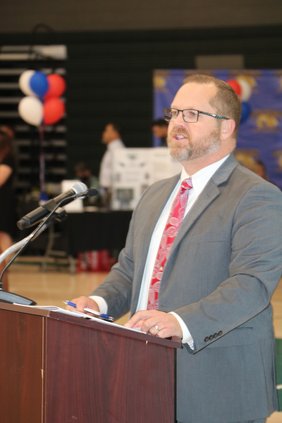One plus one equals two.
The ability of Manteca Unified to get that and endless other lessons across to 23,660 students is rooted in another equation.
One minus one equals zero.
It’s shorthand for the zero sum budget strategy MUSD has successfully pursued for years.
It enabled the district to bring stability to its finances to minimize the negative impacts from the ebb and flow of California’s education funding methodology based on the state’s heavy reliance on taxation of capital gains.
Superintendent Clark Burke during his State of the District report earlier this month tied MUSD achievements in the classroom and actions supporting what is done there into its commitment to zero sum budgeting to lay the financial foundation.
“Our mission meant developing a needs-based and zero-sum budget, establishing a measurable baseline using critical data to drive change, hiring and retaining quality employees, and empowering our community as partners in education, “ Burke said during the presentation at a school board meeting conducted in the new Manteca High gym. “This was no easy feat and certainly not a one-size-fits-all approach — because we know that every student requires a unique educational pathway.”
Zero sum budgeting is an obvious concept.
In its most basic form zero-based budgeting is when your income minus your expenses equals zero. It is driven by a commitment to make sure every dollar has a purpose, a job, and a goal. Nothing is left hiding or getting mindlessly spent.
Using that philosophy as a base the district has:
*Avoided using one time funds for ongoing expenses.
*Used the most restricted funds in a manner it has taken pressure off general fund expenses. As an example, if air conditioning replacement with high quality air filters qualified for COVID funding, the district used that money instead of general fund revenue set aside to pay for planned upgrades.
*Built reserves in a manner that they can obtain state blessing for stable three-year budgeting.
*Partnered with employees on establishing a multi-year contract that commits 85 percent of all new unrestricted general fund revenue beyond inflation and student growth from the state to go to salaries and benefits as decided by employee bargaining groups. That is based on the fact 85 cents of every general fund $1 historically goes to employee salaries, benefits, and retirement.
The 85 percent commitment can’t be emphasized enough.
It not only has reduced the tremendous time and energy that salary negotiation can take on a year-to-year basis but it has freed up the district and teachers to concentrate on addressing other issues needed to support the effort in the classroom.
The budget approach also has led to the district refraining from getting ahead of money by hiring teachers and support staff that they might then have to let go if the state ends up delaying payments in economic downturns as they have done in the past..
Other districts often find themselves in that situation. And even if they don’t actually let people go, the simple activation of the notification process that is required well in advance by the state in order for a district to have an option to make such a move undermines staff stability.
A serious commitment to multiple year budgeting has allowed the district to avoid that pitfall.
At the same time the judicious use of the most restricted funds put the district in a position to use the substantial windfall from COVID funding to get ahead of most other districts and hire teachers in advance to avoid the shortages the pandemic created.
Among highlights in the report accompanying Burke’s presentation:
*The district has 20 TK-8 schools, three comprehensive high schools, an online school program, two alternative high schools, an adult school, and 26 pre-school classes.
*The graduation rate is 95 percent based on the 2020-2021 school year.
*1,679 students are bused daily.
*There are 1,305 certified staff (teachers, administrators, counselors, etc.) and 1,170 classified that serve as support staff for everything from clerks and secretaries to campus monitors, bus drivers, and custodians.
*There are 23,660 students. The State of California classifies 67.7 percent of the students as socioeconomically disadvantaged with 20.3 percent of the students being English language learners.
*The district covers 113 miles and serves the cities of Manteca, Lathrop, and Stockton as well as the township of French Camp and the unincorporated rural area of Manteca.
*The 2019-2020 budget had $328.8 in expenditures.
*The district has an AA- rating from S&P Global as well as an Aa2 and Aa3 rating from Moody’s that reflects its effective fiscal management.
*Two percent of the district’s revenue comes from local sources. The rest is Local Control Funding Formula that doles out a mixture of property taxes and state revenue to local schools based on a formula that includes socio-economic needs and funding overall, 12 percent from the state, and 15 percent from the federal government.
*Of every dollar spent in the general fund, 32 cents are on certificated salaries, 12 cents on classified salaries, 5 cents on management salaries, 21 cents on employee benefits, 14 cents on books and supplies, 10 cents on services and operating costs such as electricity, 4 cents on capital outlay and 2 cents on other needs.
To contact Dennis Wyatt, email dwyatt@mantecabulletin.com





